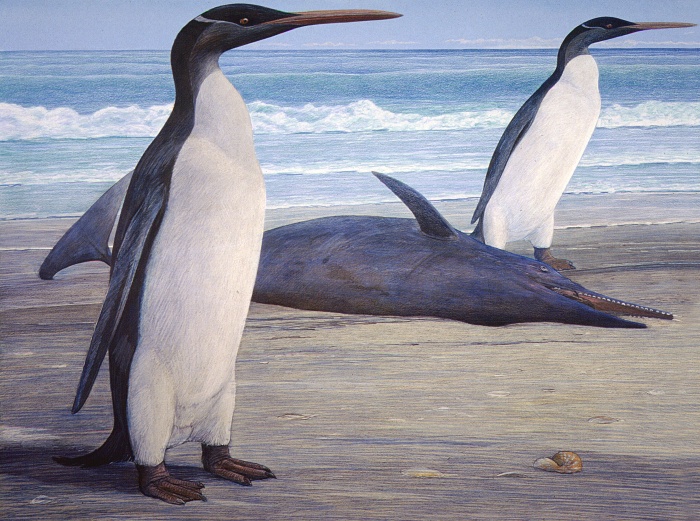Introducing Kairuku!
Today, two new fossil penguin species formally enter the scientific catalog. These 27 million year old penguins are unique, “svelte” species with graceful proportions discovered in New Zealand. I worked on these incredible fossils in 2009 and 2011 with Dr. Ewan Fordyce of the University of Otago and former Otago students Dr. Tatsuro Ando and Dr. Craig Jones (now at the Ashoro Museum of Paleontology and Institute of Geological and Nuclear Sciences, respectively) on a scientific article describing the new species and the new details they reveal about penguin evolution. Our findings are now published in the latest issue of the Journal of Vertebrate Paleontology.
So, what makes Kairuku so special? The three skeletons discovered are among the most complete ever recovered for an ancient penguin. They reveal that Kairuku penguins cut a striking figure. They had more slender proportions than living penguins, with an elongate trunk, narrow bill, and long, narrow wing bones. The legs, on the other hand, were quite robust. Overall, the skeleton conveys a very elegant bird, sleek yet powerful. And, they were tall. A standing Kairuku penguin would have reached about 4 feet 2 inches, more than a foot taller than an Emperor Penguin. Artist Chris Gaskin created a meticulous reconstruction of the new species that really drives these features home. You can practically feel the wind whipping sand and ocean spray into the air as the two penguins come ashore.

Two Kairuku penguins come ashore, passing a stranded Waipatia dolphin. Artwork by Chris Gaskin, owner and copyright owner: Geology Museum, University of Otago. Used with permission.
The name Kairuku is taken from Maori language, and loosely translates to “diver who returns with food”. Kairuku waitaki is named for the large river that flows through modern Canterbury and Otago. Kairuku grebneffi is named in honor of the late Andrew Grebneff, who contributed to the field collection and preparation of many of the fossil specimens of both species.
The first Kairuku specimens were discovered by the great New Zealand zoologist and paleontologist Dr. Brian J. Marples in the 1940s, but these bones were not immediately recognized as belonging to a new species because they were not very well preserved and typically included only a few pieces of the wing skeleton. Highly complete skeletons were later recovered by Dr. Ewan Fordyce, starting with a wonderful discovery along the banks of the Waihao River in 1977. This skeleton, a beautiful set of orange fossil bones embedded in soft greensand matrix, would turn out to be the holotype specimen of Kairuku – the standard by which all Kairuku specimens shall henceforth be compared to. Over the next 35 years, many more Kairuku specimens have been found. In fact, the most recent was collected only two months ago during our field excursion in New Zealand.
Congratulations on getting this published! I’m looking forward to reading the paper, although it’s not online quite just yet.
Bobby
February 27, 2012 at 3:59 pm
[…] dubbed the penguin Kairuku, a Maori word that loosely translates to “diver who returns with food.” Ksepka was […]
New Zealand fossil penguin reconstructed | Dear Kitty. Some blog
February 27, 2012 at 4:06 pm
Thanks Bobby. The article will be made freely available as a PDF on February 29th, and hard copies should arrive in Journal of Vertebrate Paleontology subscribers mailboxes a few weeks later.
Dan Ksepka
February 27, 2012 at 5:13 pm
THIS PENGUIN IS AMAZING!!! if it was still alive I bet we could watch Penguin Week just like Shark Week!!!
keci
February 27, 2012 at 6:28 pm
Excellent find and congrats on getting this published!
chrislindsay9
February 27, 2012 at 9:30 pm
I’m very sad to hear about Andrew. I hadn’t heard! 😦
He was definately a unique character, and I was rather fond of him. It is a nice touch of you guys to name a penguin after him!
Traumador the Tyrannosaur
February 27, 2012 at 9:43 pm
Hi Dan,Congrats on the paper One thing New Zealand has is a large and diverse range of penguins recent and fossil and i still have two species of fossil penguins yet to be identified and added to this list.
daveallen
February 28, 2012 at 4:02 am
Dear David, Thanks very much. I’d be very interested to hear more about your unidentified penguins, feel free to contact me via my academic phone / address / email:
http://www4.ncsu.edu/~dtksepka/DanKsepka/Index.html
Dan Ksepka
February 28, 2012 at 10:20 pm
[…] "CRITEO-300×250", 300, 250); 1 meneos Reconstruyen dos pingüinos gigantes Kairuku que habitaron Nueva Zelanda en la prehistoria [ENG] fossilpenguins.wordpress.com/2012/02/27/introducing-kairuku/ por a_landau hace […]
Reconstruyen dos pingüinos gigantes Kairuku que habitaron Nueva Zelanda en la prehistoria [ENG]
February 28, 2012 at 6:53 am
Congratulations to the entire team – it’s great to see how much coverage these penguins are receiving. I can’t say enough positive things about Chris Gaskin’s life reconstruction, and what a fine choice of taxon to honor Mr. Grebneff’s contributions to science.
min0u
February 28, 2012 at 9:28 am
[…] first fossils of an enormous aquatic bird were already discovered in 1977 by Ewan Fordyce, but researchers found out only recently that these fossils comprise the Kairuku penguin. This elegant predator’s name is Maori for […]
Why an extinct penguin made us think of Kodak
June 21, 2012 at 8:33 am
[…] fossielen van een enorme aquatische vogel werden in 1977 al ontdekt door Ewan Fordyce maar het is pas net duidelijk geworden dat het hier gaat om de Kairuku pinguin. De naam van dit elegante roofdier komt uit het Maori en […]
Waarom een uitgestorven pinguïn ons aan Kodak deed denken |
December 4, 2012 at 9:24 am